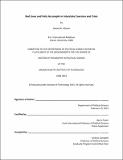Red lines and faits accomplis in interstate coercion and crisis
Author(s)
Altman, Daniel W. (Daniel William)
DownloadFull printable version (4.480Mb)
Other Contributors
Massachusetts Institute of Technology. Department of Political Science.
Advisor
Barry Posen
Terms of use
Metadata
Show full item recordAbstract
The International Relations literature has an established view of interstate crises that explains how states pursue victory in terms of signaling resolve. States make gains with credible coercive threats (compellence). In contrast, this dissertation conceives of each crisis as a strategic competition between a challenger seeking to make gains unilaterally by fait accompli and its adversary's countervailing efforts to set red lines to deter these faits accomplis. After clarifying the neglected concepts of "red line" and "fait accompli," the dissertation takes up two questions the literature has left unexplored: When are faits accomplis likely to occur? When are they likely to lead to war? The result is a theory of coercive conflict explaining why deterrent red lines that contain any of four weaknesses -- types of gray areas, in essence -- are especially vulnerable to faits accomplis. This theory is tested with two case studies -- the 1948-1949 Berlin Blockade Crisis and the 1962 Cuban Missile Crisis -- and an analysis of gray areas and land grabs in territorial crises since 1918. Making extensive use of declassified documents, the case studies show that the "game" of crises need not be a matter of convincing the adversary of one's willingness to fight. Instead, states pursue victory by finding gray areas and other weaknesses in deterrent red lines that they can exploit to unilaterally take as much as possible -- often by fait accompli -- without crossing the line and overtly firing on the other side. Crises, from this standpoint, are a game of finding ways to advance without attacking. The analysis of territorial crises makes use of original data on all land grab faits accomplis since 1918. It shows first that states far more often make territorial gains by fait accompli than by coercing a territorial cession. It then focuses on the impact of geographical gray areas, which take two forms: islands located awkwardly between two core territories and border ambiguities. It finds that two-thirds of all land grabs since 1918 targeted a gray area. These gray areas render faits accomplis more effective at making a gain without provoking war and, consequently, more likely to occur.
Description
Thesis: Ph. D., Massachusetts Institute of Technology, Department of Political Science, 2015. This electronic version was submitted by the student author. The certified thesis is available in the Institute Archives and Special Collections. Cataloged from student-submitted PDF version of thesis. Includes bibliographical references.
Date issued
2015Department
Massachusetts Institute of Technology. Department of Political SciencePublisher
Massachusetts Institute of Technology
Keywords
Political Science.